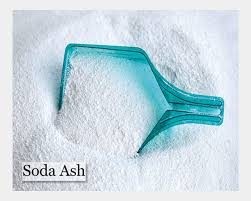
Soda ash (Na2CO3), also known as sodium carbonate or washing soda, is a white, odorless and non-toxic organic salt of sodium. It is generally found in natural deposits and can also be acquired from the ashes of plants growing in sodium-rich soils. Soda ash belongs to the Chlor-alkali family and is widely used in numerous industries owing to its disinfectant properties.
It acts as a vital component in bleach, stain removers, sanitizing sprays, laundry detergents, all-purpose cleaners and automatic dishwashing detergents. It is also utilized as a fungicide, microbicide, herbicide and as a pH adjuster in personal care products.
The global soda ash market attained a total volume of nearly sixty-three million (63,000,000) tons in 2020. Since 2010 global demand has grown by three point five percent (3.5%) per year vs trade growth of four point three percent (4.3%) per year.
Rising population and use of detergent and container glass in emerging economies would drive the soda ash market during the forecast period of 2023-2028 at a compound annual growth rate (CAGR) of two percent (2%) to reach a volume of seventy-one million (71,000,000) tons.
Factors like increasing the use of Soda Ash in the Glass Industry, as Soda Ash is the crucial ingredient in the manufacturing of glasses, as it is used as a fluxing agent to reduce the melting point of silica, are expected to drive the global soda ash market.
Furthermore, the use of Soda Ash in the soap & detergent industry, the compound’s formulations is to enhance the cleansing properties, to emulsify oil stains, to reduce the deposit of dirt during washing, to provide alkalinity for cleaning, and to soften laundry water, is projected to drive the global soda ash market.
Furthermore, Soda Ash produces several chemicals such as sodium chromate and dichromate, sodium silicate, and sodium bicarbonate, and percarbonate is expected to drive the global soda ash market.
Soda ash is typically prepared with the help of the Solvay process. In the Solvay process, ammonia and carbon dioxide are passed into a saturated solution of sodium chloride (kept at a relatively low temperature). This triggers certain chemical reactions, resulting in the formation of sodium hydrogen carbonate.
This compound is only very slightly soluble in the presence of sodium ions (as a consequence of the common-ion effect). Therefore, the sodium hydrogen carbonate is almost completely precipitated. It is then removed via the process of filtration and subsequently ignited in order to produce soda ash.
Soda ash which is a crucial raw material input for so many industries such as food, paper, chemical, glass, textile etc has been in the country's importation list for so many years, this has contributed in draining the nation's foreign exchange earnings. Nigeria presently, imports about one hundred and eighty thousand (180,000) metric tons per annum of soda ash, with glass industry consuming about fifty thousand (50,000) metric tons per annum.
The importance of soda ash as an industrial input (in terms of national demand) cannot be over emphasized and Nigeria stands to benefit economically if a processing plant could be established in the country. Apart from the trona purification method, the synthetic production technique is economically viable and available.
The needed raw materials are available in the country and the machinery and technology can be sourced from abroad, while we work on developing our own technology.






















